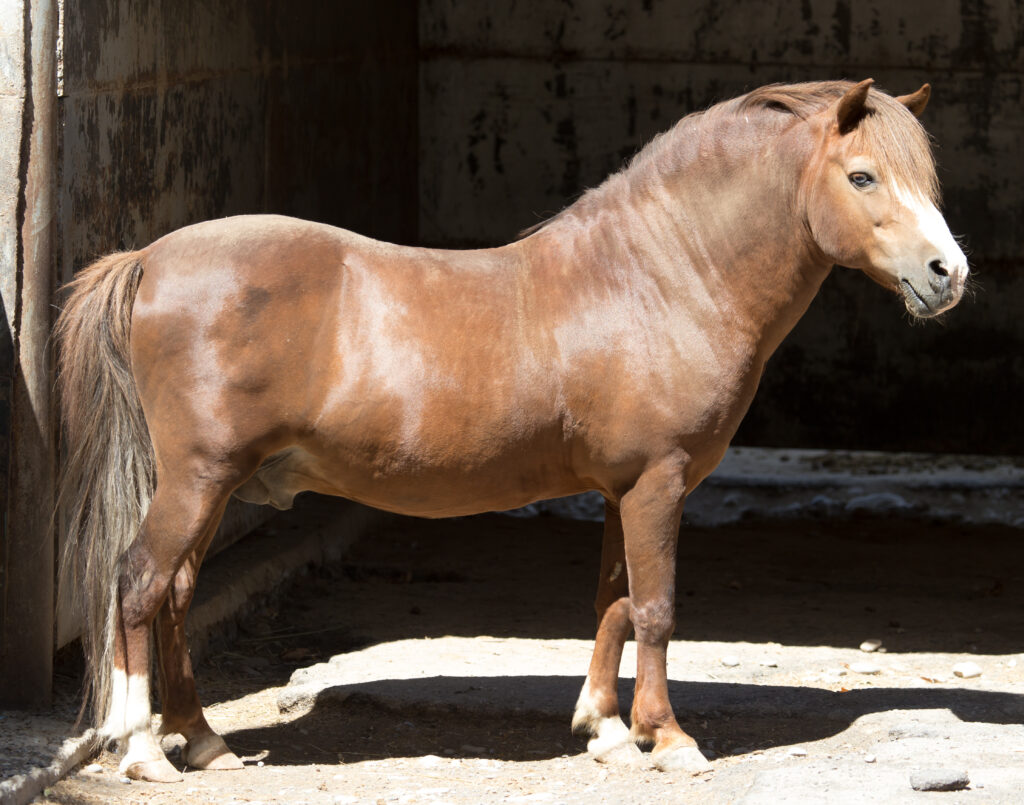This article originally appeared in the Winter 2025 issue of EquiManagement. Sign up here for a FREE subscription to EquiManagement’s quarterly digital or print magazine and any special issues.

In a February 2025 webinar, David Rendle, BVSc, MVM, CertEM(IntMed), DECEIM, FRCVS, RCVS, European Specialist in Equine Internal Medicine, shared updates to the information he presented on SGLT2 inhibitors (SGLT2i) at the 2024 AAEP Convention. SGLT2i work by blocking the kidneys’ proximal convoluted tubules to increase blood glucose secretion into urine, which helps reduce circulating insulin concentrations. SGLT2i act predominantly on the renal level, while SGLT1i act mainly on the intestines and pancreas.
SGLT2 inhibitors have a multitude of beneficial effects on horses. They can:
- Lower plasma glucose to help with hyperinsulinemia and insulin dysfunction.
- Lead to urinary calorie loss and weight loss.
- Lower adiponectin and leptin.
- Lower plasma volume and blood pressure.
- Reduce adipocyte-mediated inflammation.
- Shift to ketone metabolism.
- Reduce oxidative stress.
- Lower uric acid.
- Reduce glomerular hyperfiltration and albuminuria.
- Suppress glycemic end product signaling associated with inflammation.
While Rendle stresses the importance of lifestyle and diet to control equine metabolic syndrome, he acknowledged cases in which horses might need pharmacological intervention in addition to owner compliance implementing management changes. Some horses are resistant to weight loss, particularly if they cannot exercise because of laminitis or other musculoskeletal issues. Rendle said an SGLT2i might be a necessary premedication in advance of corticosteroid treatment in horses at high risk of laminitis.
Pasture-Associated Laminitis
In a prospective cohort study of 446 horses, Menzies-Gow et al. evaluated risk factors for pasture-associated laminitis in the U.K.1 Three-quarters of the horses were overweight/obese (BCS 7-9), 27.3% were ideal weight (BCS 4-6), and 0.5% were underweight (≤ 3 BCS). After one year 4% developed laminitis; after two years 6.7% developed laminitis; and after three years nearly 10% developed laminitis. Risk factors for pasture-associated laminitis included low plasma adiponectin and high serum basal insulin or insulin post-dexamethasone administration.
Laminitis Risk Based on Insulin Dysregulation
In another study of 374 normal ponies without present or previous laminitis, Knowles et al. reported that 69% of horses with insulin concentrations higher than 45.2 µIU/ml will develop laminitis within four years. Twenty-two percent of horses with insulin levels of 21.5-45.2 µIU/ml had a risk of developing laminitis within four years.2
Rendle stressed that even horses with appropriate BCS can experience postprandial hyperinsulinemia and are at risk for laminitis. In another study, 28 insulin-dysregulated horses (insulin > 100 µIU/ml) were fed forage withwater-soluble carbohydrate content either below or above 10%.3 Most (25/28) of the horses had a history of laminitis but no ongoing acute episode and no PPID. They received feed in appropriate amounts per kilogram of body weight. The researchers performed oral sugar testing following several days of feeding specific nonstructural carbohydrate diets:
- Hay for 14 horses.
- Haylage for 13 horses.
- Hay and haylage for one horse.
Many of the horses had peak insulin > 21. Insulin levels of 150-200 µIU/ml occurred in 14% of the ID horses.
The authors concluded that “feeding forage with < 10% WSC content is not always enough to avoid postprandial hyperinsulinemia beyond the level at risk to induce laminitis in horses with moderate to severe ID.” Such individuals might do better on SGLT2i drugs, said Rendle.
Effects of the SGLT2i Ertugliflozin
In a horse owner survey of SGLT2 inhibitors, 342 respondents used ertugliflozin. Many of the horses received treatment for 3 to 12 months, with 85% improved, 9% unchanged, and 5% deteriorated. All respondents noted that laminitis pain improved within 30 days. Three-quarters of the patients were on non-steroidal anti-inflammatories (NSAIDs) at the start of treatment; 19% remained on NSAIDs following treatment. Eighty percent of horses whose owners were considering euthanasia prior to treatment had mild or absent pain after 30 days on SGLT2i. Adverse effects cited included polyuria/polydipsia (PU/PD), excessive weight loss, and dullness. None experienced hyperlipidemia, which is a concern with SGLT2i.
Hypertriglyceridemia is a side effect of SGLT2i treatment and might prompt practitioners to consider a dose reduction. Normal triglyceride reference ranges vary but are typically around 0.1-6.2 mmol/L. “Once triglyceride levels reach the teens (mmol/L), it is concerning, but we have seen over time that levels normalize,” said Rendle. “If there are high lipids in the serum, that is concerning, and if triglyceride levels are in the 20s, then consider reducing SGLT2i dose. It is important to ensure that the horse continues eating. If fasting is anticipated, then withdraw treatment for a period of time.”
In a veterinary survey, 45% of respondents reported seeing no adverse effects from SGLT2i. Others reported PU/PD, urinary tract infection, and inappetence but no hyperglycemia. Treatment was discontinued upon laminitis resolution or reduced insulin levels. Very few owners stopped treatment because of high triglycerides or other biochemical markers; most stopped due to cost.
Take-Home Message
Rendle stressed that SGLT2i drugs should be used when other management or pharmaceutical options have not worked and at as low a dose and as short a time as possible. He noted that SGLT2i products are not interchangeable. Presently, ertugliflozin is indicated for acute laminitis. Use of these drugs should be reevaluated monthly, preferably with information from clinical exams and insulin concentrations. He said frequent lab testing might be cost-prohibitive, so veterinarians should pursue it judiciously. Upon reaching the target clinical response, he recommends reducing the dose by half and reassessing, then discontinuing and reassessing. It might be possible to go down to a one-quarter dose while weaning the horse off SGLT2i.
It is important to note that SGLT2i can be used with pergolide because many PPID cases are hyperinsulinemic with high ACTH levels; pergolide has no effect on lowering insulin levels. Currently, there’s no data to support the use of SGLT2i with pergolide, which veterinarians should explain to owners.
References
- Menzies-Gow NJ, et al. Prospective cohort study evaluating risk factors for the development of pasture-associated laminitis in the United Kingdom. Equine Vet J. 2017 May;49(3):300-306.
- Knowles EJ, et al. Predictors of laminitis development in a cohort of non-laminitic ponies. Equine Veterinary Journal 2023, vol 55 (1), pp. 12 – 23.
- Svonni E, et al. Postprandial insulin response to feeding forage with different carbohydrate content in horses with moderate to severe insulin dysregulation – preliminary results from an ongoing study. Presented at the 5th Global Equine Endocrine Symposium 2023 in Bern, Switzerland.
Related Reading
- How Endocrine Disorders Impact Equine Athletes
- Groundbreaking Equine Endocrine Research
- Disease Du Jour: EMS and ID
Stay in the know! Sign up for EquiManagement’s FREE weekly newsletters to get the latest equine research, disease alerts, and vet practice updates delivered straight to your inbox.


![[Aggregator] Downloaded image for imported item #18375](https://s3.amazonaws.com/wp-s3-equimanagement.com/wp-content/uploads/2025/09/30140031/EDCC-Unbranded-26-scaled-1-768x512.jpeg)

